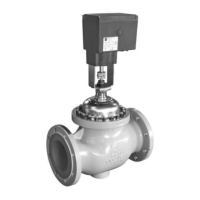EB 3018 EN 1-1
Safety instructions and measures
1 Safety instructions and measures
Intended use
The Type42-36E Pressure-independent Control Valve (PICV) with an electric actuator is in-
tended for ow control of liquids up to 150°C and gases up to 80°C. It consists of a
Type2423 Valve, a Type2426 Actuator and an electric actuator. The regulator is delivered
as separate components.
The pressure-independent control valve is mainly used to control liquids or gases in district
heating supply networks.
The regulators are designed to operate under exactly dened conditions (e.g. operating pres-
sure, process medium, temperature). Therefore, operators must ensure that the regulators are
only used in operating conditions that meet the specications used for sizing the devices at
the ordering stage. In case operators intend to use the regulators in applications or condi-
tions other than those specied, contact SAMSON.
SAMSON does not assume any liability for damage resulting from the failure to use the de-
vice for its intended purpose or for damage caused by external forces or any other external
factors.
Î Refer to the technical data and nameplate for limits and elds of application as well as
possible uses.
Reasonably foreseeable misuse
The regulators are not suitable for the following applications:
− Use outside the limits dened during sizing and by the technical data
− Use outside the limits dened by the additional ttings mounted on the regulator
Furthermore, the following activities do not comply with the intended use:
− Use of non-original spare parts
− Performing service and repair work not described
Qualications of operating personnel
The regulator must be mounted, started up, serviced and repaired by fully trained and quali-
ed personnel only; the accepted industry codes and practices must be observed. According
to these mounting and operating instructions, trained personnel refers to individuals who are
able to judge the work they are assigned to and recognize possible hazards due to their spe-
cialized training, their knowledge and experience as well as their knowledge of the applica-
ble standards.

